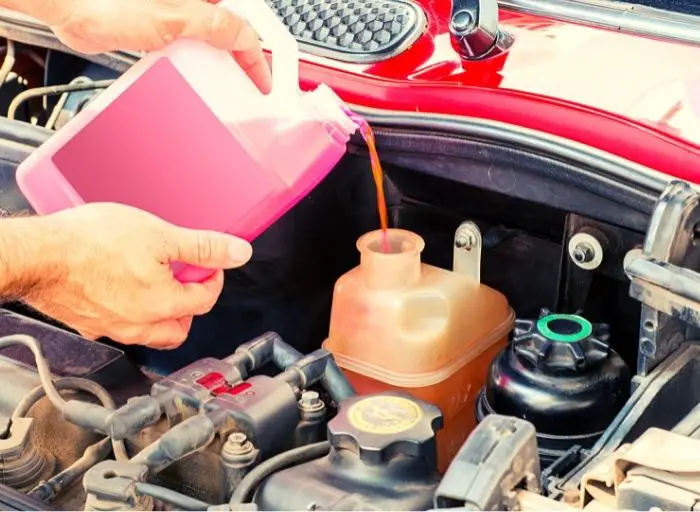
What happens if the coolant is low? Your car relies on antifreeze, also known as engine coolant, to keep the engine at the proper operating temperature. Driving with low coolant can cause your engine to overheat, which can be disastrous for your engine and the vehicle.
Table of Contents
What Happens if The Coolant Is Low
Low coolant levels can cause damage to key parts of your car, causing costly repairs. Here are some of the consequences of driving with low coolant.
It’s possible that your engine heats up
Coolant aids in the removal of heat from the engine. As a result, if there isn’t enough fluid, the engine may overheat or seize. Continuing to run an overheated engine might result in irreversible destruction, like pistons welding to the cylinders.
Your car may turn off
Some vehicles feature a safety mechanism that will turn off the engine if it suffers considerable damage, which can occur due to a lack of coolant. While this may help you avoid costly repairs due to an overheated engine, depending on where you are traveling once the engine shuts off, it can be extremely dangerous.
You have the ability to blow a head gasket
A head gasket on the engine block can sometimes blow due to a lack of coolant. You may notice smoke coming from the engine or exhaust, a reduction of power, engine banging sounds, or lower efficiency if this happens.
Other indicators
You may notice billowing steam, a scorching hot bonnet, and no control over the internal heating system, in addition to engine problems.
What Are the Symptoms of Low Coolant?
There are various symptoms that point to a defective cooling system before your engine overheats or shuts down.
1. The temperature gauge is increasingly red
When everything is in order, you grow accustomed to the location of the temperature gauge after some time behind the wheel. If it begins to turn red, it’s one of the first signs that anything is amiss with the cooling system. Pullover and lift the hood if you observe this while driving. This will let the engine cool down and allow us to begin diagnosing the issue.
2. Heater isn’t working or isn’t providing enough heat
The leftover heat created by your engine is used by your car’s heater. You can have trouble with the internal heating system if your cooling system breaks down. This can be a continual stream of hot air or an absolute lack of heat, both of which are signs that your cooling system is malfunctioning.
3. Inefficient fuel economy
Fuel will burn efficiently if the motor is working at optimum temperature, resulting in reduced usage. However, as the temperature rises, you’ll notice a drop in fuel economy and an increase in emissions.
4. Typical coolant smell
A pleasant sweet odor emanates from the coolant. You might detect it in the cabin if it leaks owing to high heat. Being aware of this odor can aid in the diagnosis of a cooling system failure before it causes serious damage.
Common Coolant Loss Causes
While engine oil can be changed every 3,000-5,000 miles, coolant doesn’t need to be checked or replaced as frequently. In fact, because coolant is contained within a closed system, it should not grow low unless there is a leak, in this case, you should seek radiator servicing and repairs from your local car care professionals. The coolant fluid can escape in a variety of ways, including:
- External leaks caused by radiator hoses, hose connections, or the radiator itself
- The coolant can leak out of the radiator cap due to a poor seal on the cap.
- Internal leaks, like the engine’s head gasket, might cause coolant to flow out.
Is It Safe To Drive With A Low Engine Coolant Level?
Coolant, antifreeze solution, radiator, thermostat, and hose pipes that move the coolant around make up the cooling system. The coolant’s primary job is to absorb heat generated by the engine and send it to the fan and the radiator for cooling. The thermostat controls how much coolant is supplied to the radiator and the engine.
The engine’s internal combustion unit generates a huge amount of heat, which can reach temperatures above 200 degrees. The amount of coolant can be reduced due to a leaking hosepipe. If the problem is not fixed quickly enough, various engine components may begin to fail. As a result, driving with low engine coolant is dangerous since it might induce air bubbles in the system, that can harm your engine.
How Long Can I Drive If My Coolant Is Low?
When your coolant level is low, you can usually still drive your car for a while. However, it is dependent on the coolant level. If the coolant levels have dropped but are above the minimum, you can still drive the car for a few days; however, if the coolant level is below the minimum, please do not attempt to drive your car in this manner to avoid knocking your engine. You must replenish the coolant.
Conclusion
Coolant is essential for keeping your car’s engine cool. Leaking hosepipes, leaking gaskets, malfunctioning radiator caps, faulty heaters, and an overflow reservoir can all contribute to low engine coolant.
It is not suggested to drive or operate your vehicle with low coolant levels because this can cause engine damage. This is why it is critical to diagnose the problem as soon as possible because repairing a small component is much less expensive than purchasing a new engine.
Hi there! I’m Naomi O’Colman. I’ve got years of experience working at an auto repair shop here in Texas under my belt. On top of that, ever since I was a kid I’ve been passionate about the auto industry. Since I’ve joined the team at automotivegearz.com I’ve been enthusiastically sharing my passion and insights with my readers. I’m dedicated to delivering high quality content and helping you stay up to date with the latest automotive trends and products out there!







